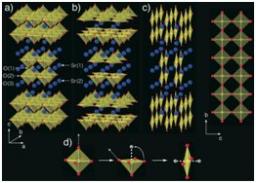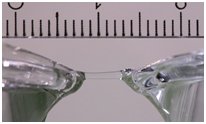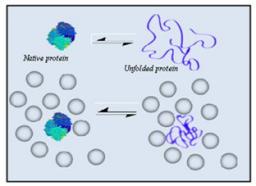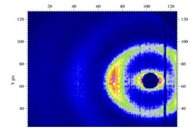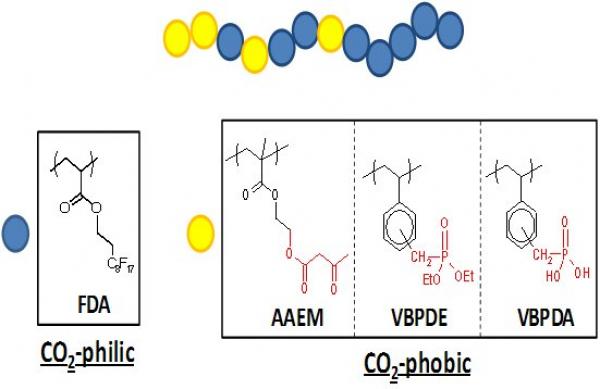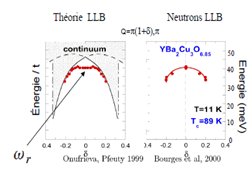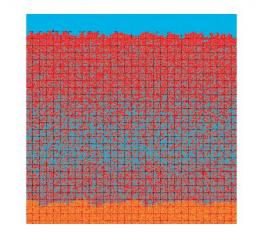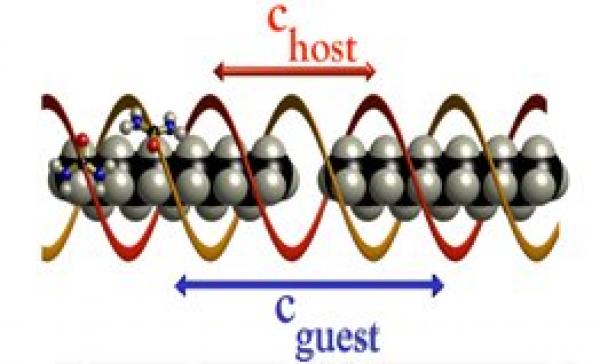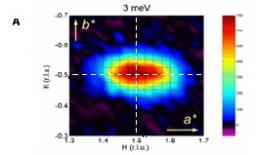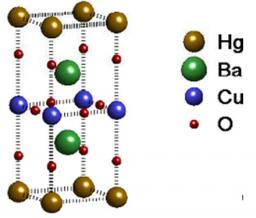2010
The improvement of the mechanical properties of polymer films by inclusion of mineral particles is a well known industrial practice used since the end of the XIX century. A classical example is the rubber industry for which the addition of carbon black as fillers permits to increase the elastic modulus of the pneumatics. Nevertheless, the mechanisms which govern the reinforcement properties are still not completely described by experiments and theory.
More recently, the use of fillers of nanometric size and of controlled geometry like colloidal silica allowed significant advances in the understanding of these mechanisms and in the conception of innovative materials. In this context, an original approach is to try to improve and to control the specific properties of the material with an external trigger like a magnetic field. We have obtained polymer films with anisotropic mechanical properties by inclusion of magnetic particles inside the matrix which can be aggregated in a controlled way during the film processing and oriented with an external magnetic field. The orientation of the fillers during the processing condition with the field is a new approach when magnetic composites are usually exploited to modulate the mechanical properties after the synthesis. More...
The concept of "spin ladder" originally appeared to study the theoretically still controversial antiferromagnet (AF) 2D square lattice in high temperature superconducting cuprates starting from a well understood 1D AF chain [1-2]. They can been schematized as an array of finite number of coupled chains .The motivation of theoretical investigations has been to test how the one-dimensional (1D) S=1/2 AF chain system (n=1), that is rigorously solved even when doped with carriers, could be connected to the 2D square lattice (n=∞) that in turn encounters various theoretical difficulties and is far from being understood. Experimentally, Srn-1CunO2n-1 has been the only example representing a generalized spin-ladder system [3-5]. More...
In 1893 Sir William Armstrong reported a remarkable experiment: if a high voltage is established between two wine-glasses filled to the brim with pure water and connected by a cotton thread, a rope of water is formed and remains suspended between the lips of the two glasses. This "water bridge" can subsist for a few seconds even once the thread has been removed [1].
Recently, a group of physicists from Graz University, Austria [2] succeeded on establishing a bridge (without any thread!) between the two glasses under a voltage of 20 kV. The length of the bridge may reach values larger than 1 cm, its diameter is of the order of a few mm and the lifetime currently exceeds 1 hour. Under the effect of the electrical field, the local temperature increases and reaches 60° C, a temperature sufficient to break the bridge. More...
Voir aussi le fait marquant :
- Des neutrons pour étudier la structure de l'eau : le pont d'eau lourde
/ See also the IRAMIS highlight:
- Neutrons to investigate the structure of water : the heavy water bridge
Light-harvesting antennae are pigment-protein complexes involved in light-absorption and excitation energy transfer (EET) to the so-called "reaction center" complexes, where the photochemical processes of photosynthesis take place. C-phycocyanin (C-PC) is one component of the phycobilisome, the light-harvesting system of cyanobacteria [1]. In phycobilisomes, EET is a highly efficient key event [2-3], where light-induced dynamics of the antenna pigment/protein complexes may play a role [4-7].
To detect fast and localized protein motions at room temperature, related to light absorption and EET in the isolated pigment/C-PC protein system, as well as to investigate the timescale of such dynamical changes, we developed a new experimental setup on the time-of-flight spectrometer MIBEMOL (LLB, France). This new "time-resolved" method was technically challenging, since we had to synchronize pulsed inelastic neutron scattering measurements with repetitive light excitations. The principle of the experimental setup is shown in Fig. 1. The laser was fixed outside the sample well of MIBEMOL spectrometer, perpendicularly to the neutron beam and in front of the detectors (Fig. 1A). The photon beam was directly aimed on the sample through the 10 mm-diameter hole of an "integrating sphere" (Fig. 1, B and C), without any additional optical device. We used a spherical and hollow aluminium chamber, containing a highly reflective and diffusing interior coating, to illuminate the sample inside uniformly. More...
Following the synthesis by the ribosome, to carry out its biological function, a protein much fold into a single, well defined conformational state: the native state. Protein folding is thus the physico-chemical process by which a polypeptidic chain undergoes a structural change from an ensemble of coil like structure up to the unique structure encoded in its amino-acid sequence. This process is fascinating and remains one of the most challenging problems of structural biology. Protein misfolding is involved in number of pathologies such as BSE an Alzheimer diseases. More...
The use of agricultural resources for industrial purposes will undoubtly be one of the major challenges of the 21 st century. Organic biosynthons used in chemistry should progressively replace those coming from fossil fuels. Our work on dispersions of fatty acids and hydroxylated derivatives forms part of these efforts in that it seeks to demonstrate the potential contribution of fatty acids (which may be extracted from plants) as a new class of surface active agents. Dispersions of fatty acid and their hydroxyl derivatives are thus studied in solution in order to generate a new class of surface active agents for foaming and emulsifying properties.
However, it is known that fatty acids and their hydroxylated derivatives are insoluble in water. Our initial studies thus targeted the physiochemical conditions which would enable dispersion of these compounds. Using commercial fatty acids as model systems, we produced dispersions by using a large variety of counter-ions such as soluble organic amines (ethanolamine, lysine...). These salts made it possible to obtain homogeneous dispersions with considerable polymorphism, which formed micelles [1], vesicles [2], nanotubes [3, 4], cones [5] and torsades [6]. Preliminary studies in foams and emulsions have demonstrated that their stability differs as a function of polymorphism [7]. More...
This work is part of a theoretical project which aims to unravel the mechanism at work in the high temperature cuprate superconductors. In the recent article [1] we have studied the role of spin fluctuations, and namely of the collective spin mode, for the superconducting pairing and numerous electronic anomalies observed in cuprates. This mode strongly coupled to the electrons (which develops in the vicinity of the antiferromagnetic wave vector and has an anomalous downward dispersion) was first predicted theoretically [2] and then observed by neutrons [3]. More...
This study investigates the long term behavior of glasses used for confinement of nuclear wastes. The results have been obtained from a fruitful collaboration between different CEA laboratories (LLB, LIONS, CEA Marcoule) and the Ecole Polytechnique. The corrosion process of the glasses by water creates at the glass surfaces, an alteration porous layer, hydrated and amorphous, called "gel". This gel, which is the result of the release of soluble elements, of hydrolyses and of silica network recondensation can in specific conditions strongly limit the exchange process between the glass and the solution. Our hypothesis to describe this phenomenon is the closure of the gel porosity. More...
Using conjugated polymers as the active materials in electronic and optoelectronic devices opens up the possibility of fabricating all-polymer devices using solution processing technologies. The fabrication of good quality field-effect transistors (FETs) is crucial to a number of polymer-based devices, such as active matrix displays and integrated circuits. Central to FET operation is the dielectric/semiconductor interface. Here we look at the interface between a polymer gate dielectric and a conjugated polymer, using neutron reflectivity. By using a mixed solvent (toluene/cyclohexane) to deposit the conjugated polymer directly on top of the polymer dielectric we are able to fabricate bilayer FET architectures with systematically controlled interfacial roughness, and study the impact on transistor performance. More...
The strongly interacting conduction electrons can be accurately represented as a gas of weakly interacting electron-like excitations. This description, known as Fermi liquid theory, works for many metallic systems. However, over the past two decades, new types of metallic materials with strongly correlated electrons have been discovered that do not fit this standard description. The list includes the superconducting copper oxides and many other materials. More...
BiFeO3 is a multiferroic materials in which ferroelectric and anti-ferromagnetic orders coexist well above room temperature (TN=643 K, TC=1093 K), with a high polarization (over 100 μC/cm2 [1]). We have shown at the LLB by neutron diffraction that these two order parameters interact and that the magnetization of the material can be modified by the application of an electric field. This opens the way towards the implementation of this material in spintronic devices in which magnetization could be controlled by a small electrical voltage rather than by currents or magnetic fields.
Although magnetoelectric materials have been known for decades, no direct proof of the coupling between the two co-existing physical effects had been reported in the literature. We have demonstrated this magneto-electric coupling by neutron diffraction on BiFeO3 single crystals. One key to success was the exceptional quality of the high purity single crystals which are magnetically and electrically single domain. More...
The pseudogap region of the phase diagram is an important unsolved puzzle in the field of hightransition-temperature (Tc) superconductivity, characterized by anomalous physical properties below a certain temperature, T*[1]. In contrast to the superconducting temperature Tc which exhibits a dome-like shape, the pseudogap phase is observed only at low doping in the underdoped region of the cuprates phase diagram. There are open questions about the number of distinct phases and the possible presence of a quantum-critical point underneath the superconducting dome. More...











